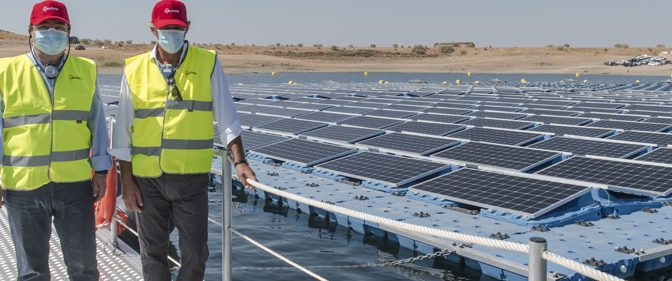Guillermo Fernández Vara, President of the Junta (Regional Government) of Extremadura, and ACCIONA President José Manuel Entrecanales today inaugurated the first grid-connected floating photovoltaic solar plant in Spain on the Sierra Brava reservoir (Extremadura).
The inauguration ceremony was also attended by Olga García, Regional Minister for Ecological Transition and Sustainability of the Junta de Extremadura, together with ACCIONA Energía CEO Rafael Mateo and Joaquín Mollinedo, ACCIONA Director-General of Institutional Relations, Sustainability and Brand.
The Sierra Brava photovoltaic plant is an innovative demonstration project that will allow the study of a range of technical solutions for the installation of solar panels on lakes or reservoirs. It consists of 3,000 photovoltaic modules of different types, distributed across five floating structures with different layouts, orientation and inclination. The aim is to analyse their performance in terms of production and the installation and maintenance costs of the different solutions.
The Sierra Brava plant is located on the southern shore of the Sierra Brava reservoir in the municipality of Zorita (Cáceres) and covers 12,000m2, i.e. 0.07% of the total surface area of the reservoir (1,650 hectares).
The environmental protection measures in the project include the installation of two floating ‘islands’ to encourage birds to nest and the provision of nesting boxes for the lesser kestrel (Falco naumanni), a protected species that lives in the area. The monitoring programme will examine the interaction between the birds and the fish stock in the reservoir with the plant and the support measures.
Emerging photovoltaic technologies
ACCIONA’s new floating plant has been designed as a technology demonstrator for the testing of a range of solar panels, inclinations and floating systems in a combined manner and in a real environment. Among the most novel elements are the double-sided panels, modules with a transparent rear surface to allow sunlight to act on the reverse side, and the totally vertical layout with an inclination of 90 degrees.
The installation will allow conclusions to be drawn on the behaviour of the different layouts and the cost-efficiency ratio obtained to find the best combination when it comes to developing floating photovoltaic plants in a specific environment of sunlight hours, wind and humidity conditions.
The floating plant at Sierra Brava is another step forward in ACCIONA’s intention to position itself in the future of photovoltaic energy through innovation.
The company has an innovation hub in its El Romero Solar plant (Atacama, Chile) where new terrestrial photovoltaic technologies are studied (materials and panels, solar trackers, cleaning and maintenance systems…) that can lead to higher efficiency and performance.
ACCIONA has also developed a pioneering hybrid solution combining wind and photovoltaic energy. It consists in covering a wind turbine tower with flexible organic panels to produce energy for the internal electricity consumption of the turbine. The system has been installed in one of the turbines in the wind farm at Breña (Albacete).
Why floating solar panels?
The field of floating photovoltaic plants is taking off as the technological development associated with it underlines its technical and economic viability, particularly in regions with low availability of land or strong competition from agricultural uses.
Floating photovoltaic has shown other advantages over its land-based equivalent, for example, higher performance at lower ambient temperature and on flat sites with high solar exposure and fewer shadows, plus ease of installation; these factors can often offset the higher initial capital expenditure involved. As for environmental benefits, floating photovoltaic reduces water evaporation in reservoirs and improves water quality as a result of lower algae growth.
Floating photovoltaic is clearly compatible with conventional large-scale hydropower. Making use of the surface of reservoirs to generate additional energy is a clear optimization of resources, both in terms of making good use of space and using existing connections to the power grid, as well as stabilizing production based on alternative generation sources. The Spanish network of reservoirs is clearly a potential direct market for this technology.


